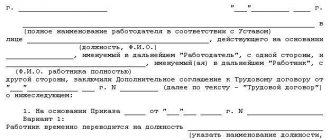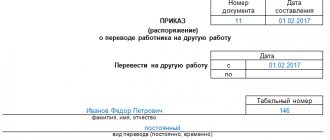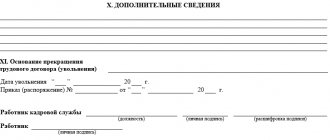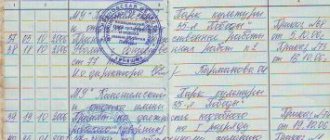The production activities of an employee of an organization or enterprise must be carried out in strict accordance with employment contracts or agreements between employees and the employer. These documents define the working conditions:
- official or professional responsibilities of the employee;
- place of performance of duties (workshop, site, department);
- internal regulations;
- salary;
- employer responsibilities;
- mutual responsibility in case of violation of the terms of the contract or labor legislation.
Any movement of an employee changes the terms of the employment relationship. All changes in the conditions of an employee’s production activity must be documented by the HR department.
The right to work, according to the Constitution of the Russian Federation, is exercised and regulated by laws, regulations and instructions of the Government of the Russian Federation, the Ministry of Labor and the Labor Code of the Russian Federation. The entry in the work book about the transfer is determined by the following documents:
- Labor Code of the Russian Federation Article 70, Article 72;
- Decree of the Government of the Russian Federation No. 225 of April 16, 2003;
- Instruction of the Ministry of Labor of the Russian Federation No. 69 dated October 10, 2003.
To avoid troubles in the future when calculating length of service when a pension is calculated, you should always carefully monitor the correctness of filling out the work book. To do this, you can ask the HR department inspector to make sure that this or that information about the transition to another position is correctly recorded.
Deciphering the concept of “translation”
The situation of official transfer of employees within one organization or from one institution to another is not uncommon. According to Article 71 of the Labor Code, the following conditions are considered a transfer:
- promotion or demotion;
- change of division, work in branches;
- change of city or country where further activities will take place;
- change of employer if the current employer requests it.
The indicated changes are translations and are therefore properly recorded. The entry of a transfer in the work book is governed by the following provisions:
- Rules approved by the Government Regulations of Russia No. 225;
- Instructions approved by Resolution of the Ministry of Social Development No. 69.
An entry is invalid if the general director made errors in its preparation.
Nuances of filling out a work book
An entry in the labor record in the order of transfer is recorded in the document of the employed person by an employee of the personnel department or the manager. At the initial stage, before making an entry, you need to make sure that the issued order is available. Next, the employee’s personal file is opened and the employment document is retrieved. The next step is to start making notes about the transfer.
The issued order is the basis for making changes to the labor law. The order that the employee will be transferred is issued in advance (2-3 days in advance). The document gains legal force after the manager signs and seals it. Each employee must freely familiarize himself with the order.
The procedure for changing information in the work book itself has nuances. The employee does not have to be present at the moment when the transfer to another position is entered into the employment record.
Registration of transfer to another position
Let's look at each situation individually in order to establish exactly what correctly left entries in the work book should look like.
How to fill out a work book when transferring?
The work book about the transfer is filled out in accordance with the requirements established by law.
You must adhere to the correct statutory language.
Also, you, as an employee of the HR department, must have legible, and most importantly, neat handwriting with which you will leave relevant notes.
Remember that no erasures should be made in the recording . It is also worth checking the seal in advance, because its placement in the document is done once, which means the seal must be accurate and distinct.
Types of transfers
To another organization
As you already know, translations may be different . Let's consider transferring an employee from one organization to another . As a rule, this practice is quite rare, but is still applicable in a number of cases, for example in cases such as the exchange of employees to learn from experience.
In the column where job information should be indicated, you write the name of your organization. Next, write that the employee was dismissed as a result of transfer.
The next entry in the work book is made by the employer of the organization to which the employee is sent. The employer also fills out the columns, but in the information column he writes the name of his organization and writes a phrase stating that the employee was hired as a transfer to such and such a position .
To another position
Internal transfer implies , as we have already said, the transfer of an employee from one position to another .
All the employer needs to do is write the date, serial number, name of the order, and also write that in the order of transfer the employee was transferred to such and such a position.
Please note that if the transfer is internal, then you do not need to write the name of the organization.
For the same position in a separate division or in another department
You write the phrase: “an employee has been hired for such and such a position as a transfer, to such and such a structural unit.” This concludes the recording.
Temporary transfer
The temporary transfer is noted in the work book accordingly . The employment record contains the following phrase: “hired to such and such a position as a temporary transfer.” From the point of view of instructions for personnel department employees, such an entry is as correct as possible.
Part-time translation
If the employee worked part-time in his position , then no matter how impossible it may seem, transfer is also provided.
So, the following type of entry is made in the work book: “the employee has been transferred from such and such a position to such and such a part-time position.”
This is where the entry ends. If the translation is not internal, then do not forget to put the name of the organization first .
Sample entry in the work book about the transfer of an employee to another position
Entry in the work record during transfer: general rules
If it is necessary to transfer an employee to another organization or position, the procedure will have the following stages:
- The employee is shown the new conditions and told about his job responsibilities, after which he agrees.
- The employee writes a statement indicating a request for a transfer to a new employer or place.
- An order is issued within three days.
- A new collective agreement is signed, changes are made to the work book and other documentation.
It is important to know! Not all cases require the employee to write a statement. If nothing depends on the employed person, his consent in the form of a statement will not be needed. Example: an enterprise is dissolved and transferred to the ownership of a new director. There is also no need to apply for a demotion if the workforce is being reduced.
The employee reads the order and signs it. If he is satisfied with the conditions, an agreement is signed. If the employee does not agree, he is laid off in accordance with established labor legislation using the appropriate wording.
Translation and relocation: what's the difference?
An employer cannot require an employee to perform work not specified in the contract. This is stated in Art. 60 Labor Code of the Russian Federation. That is, labor functions that were not initially specified in the employee’s contract can be performed by him only after changes are made to the content of the contract, drawn up in the form of an additional agreement to it.
Quite often, the transition of a worker to another job is confused with relocation. What is the difference?
A transfer is a change in an employee’s function to which he must give his consent. The following types are distinguished:
- permanent to another employer;
- temporary by agreement of the parties;
- during the absence of a permanent employee for the purpose of replacing him;
- temporary at the initiative of the employer;
- transfer to another position due to existing illnesses;
- moving to another location with an employer
These actions are possible only after receiving the employee’s consent in writing. Without consent, a transition is possible only in the event of an emergency, military action, or disaster. There is an indication of this in Art. 72.2 Labor Code of the Russian Federation.
The transfer is different in that it does not entail a change in the work function and therefore does not require the employee’s consent. In this case, the employee continues to perform the labor function stipulated by the contract and no terms of the contract established by agreement of the parties change (example: moving from one premises to another).
Special cases
A person can be transferred to a position with a record in the employment record for a permanent or temporary special case. Temporary changes in employment are carried out by agreement between the employee and the employer, which is confirmed in writing. The main reason that such a procedure is carried out is to replace an employee who is temporarily absent. The duration of such a transfer can be up to 12 months or until the return of the departed person. The corresponding entries in the labor document for transfer to a position are present with the condition of permanence in the new job, as stated in the Labor Code in Article 66.
Permanent transfer has the following types:
- Internal – with registration within the same enterprise and management.
- External, involving termination of the employment contract and change of manager.
Depending on how the scope of activity changes, the nature of the record is determined.
Temporary transfer
When transferring personnel, an entry in the work book is possible when replacing an ill or resigned employee. Even a temporary transfer with a guarantee of return to the original position is considered internal. In the process of filling out a work book, you should take into account all the rules prescribed by regulations. The employment document contains a column with information about the work, where the word “temporarily” must be added. The following text is expected for a temporary transfer with an entry in the work book: “transferred to a position...temporarily.”
Internal and external
If a person is transferred to another position, this indicates an increase or decrease in the career ladder. This type of change in activity also refers to internal due to the fact that the employee is moved to positions within the enterprise.
It is important to know! When changing a new position, the work book does not mention the name of the organization. This information will already be indicated in the line above. The emphasis is on the name of the employee’s new position. If there is an error in indicating the position, you should cross out the incorrect information and write the correct information below.
If a person is transferred outside the organization to a division or branch, this type of change of activity will be external. The nature of the information in the work book also changes. If the institution has a different name, it is registered in a separate third column. If the employee remained in the same position, but only the geography changed, the following information will be clarified: “Transferred to a division...to a position...”. In any case, the position is registered.
Dismissal due to transfer
The rules for making entries about a change of place of work or position will be regulated by 6.1 of the Instructions, which characterize the concept of transfer.
This process must be accompanied by entries in the column of the third section with working information. You should also clarify in the record on what basis the transfer took place: by agreement of the parties or at the request. Example: if a reduction in transfer occurs by agreement of the parties, it is written as follows: “termination of the employment contract occurred in connection with the transfer of the employee, by his consent, to a workplace with another employer.” This rule is regulated by paragraph 5 of part one of Article 77 of the Labor Code of the Russian Federation.
Transfer to permanent employment
If a person is transferred from a temporary workplace to a permanent one, a corresponding entry in the employment document is also made. This is explained by the fact that employees are acquiring a new permanent position, which must be documented. This is a type of internal transfer that affects the person’s working period. Entries will be made in the same way as an order issued in an institution. The entry must contain the title of the position, but without mentioning “temporary” or “transfer.” In writing, it looks like this: “Accepted for the position ... on a permanent basis.”
Translation of a part-time worker
If changes occur in the form of a shift from a part-time position to a permanent position, a corresponding order is issued and entries are made in the work book form. There is one line between the new and previous entries, and then an entry is made about the usual hiring to a new workplace.
Attention! The law does not establish an obligation in this case to register new information, since the person is already employed. But references to the fact that a transition to a permanent position has been made are necessary for the employee upon further transfer to another employer.
Basic rules for recording an employee's transfer
Before talking about the main nuances of transferring to another job, and most importantly about how to make the appropriate entry in the work book, you need to become familiar with the very concept of “transfer”.
You can find an explanation of this term in many textbooks on labor law, but it is better to refer to the original source. Thus, the labor code of our country sets out in detail information regarding what constitutes a translation. This definition is reflected in more detail in Article 72.1.
Labor Code of the Russian Federation, Chapter 12, Article 72. Changes in the terms of the employment contract determined by the parties
Changing the terms of the employment contract determined by the parties, including transfer to another job, is allowed only by agreement of the parties to the employment contract, except for the cases provided for by this Code. An agreement to change the terms of an employment contract determined by the parties is concluded in writing.
Transfer, according to general rules, is a permanent and, in some cases, temporary change in the employee’s immediate labor function, or rather the conditions in which it can be carried out.
A transfer can be a variety of actions, ranging from the transfer of an employee from position to position within an organization and ending with the transfer of an employee to another geographical area. Also, do not forget that the student can be awarded, about which a corresponding entry about the award is made in the work book.
The main rule for translation is legislative support . The transfer should be carried out only in accordance with the presence of a similar article in the labor code that would permit such an action.
Also, in order for an entry in the work book to meet the basic canons of filling out such documents, personnel officers must follow a number of very important rules.
Returning to the order,
the personnel officer must carefully read the text of the document
. The first of these is the knowledge that all information that is included in the work book must be formalized in the form of a local regulatory act, in other words, an order. In the absence of an order for relocation or transfer, the personnel officer simply does not have the right to enter data into the work book. . It is on the basis of what is written in the order that a compiled and condensed entry will be made in the labor report.
Expert opinion
Polyakov Pyotr Borisovich
Lawyer with 6 years of experience. Specialization: civil law. More than 3 years of experience in drafting contracts.
As a general rule, the dates included in the document must correspond to Arabic numerals. Filling out a work book with Roman numerals is prohibited.
This is important to know: How to fill out an electronic work book: sample 2020
Explanation in any language other than Russian is also prohibited. It is not so easy to cancel an entry in a work book, and an incorrect example of an entry in a work book about military service is canceled in court. Be careful.
Handwriting should be as neat , neat and understandable as possible.
Abbreviating words in an entry in a work record is simply unacceptable, and although many HR employees allow themselves such liberties, this is a gross violation of the instructions for maintaining and storing work records.
If a citizen working on the territory of Russia is a citizen of another republic that is part of the Federation, then it is allowed to keep entries in the work book in two languages.
Sample entries
Drawing up the main document of an employee requires serious consideration. When making entries in the labor record, the following basic rules must be observed:
- Any entries in the employment document can be made if there is a valid and signed order. Any action may be considered false without an order.
- Entries are made in Russian, in block letters or legibly by hand. Corrections and blots mean an error.
- The wording with dates is fully consistent with the text of the order document.
- If an employee lives in another republic, it is allowed to write information in several languages at the same time. But Russian is required.
- To prevent mistakes and inaccuracies, examples of making such entries with further use of the finished sample are first considered. The employee does not have the right to independently make changes to the work book.
The entry is made as follows:
- The last entry is found and the line is indented.
- The change number following the previous one is entered.
- The exact date of execution of the transfer is indicated. Changes should not be carried out even for a day.
- An indication of the position to which the person was transferred is given. The reason for changing jobs is not required. The repeated name of the enterprise is not affixed.
- The order number is recorded and the entry is signed by the manager.
Attention! Some employers mistakenly do not record a temporary transfer. But problems may begin when the second employee returns from vacation or sick leave. And also in the process of calculating length of service, all records of the labor document are taken into account.
The transfer of an employee must be documented
What is meant by transfer to another position?
Transfer to another job can be carried out either for a limited period of time or on an ongoing basis, depending on the specifics of the situation in the company.
We suggest you read: If the marriage is not formalized after the death of the husband
A transfer of such a plan can be performed in several “directions”, namely: permanent, temporary, in case of force majeure, for health reasons, transfer not dependent on the will of the parties, and so on.
Permanent transfers include the following circumstances:
- Transfer from the same employer is the “easiest” type of job change with minimal paperwork, most often used under certain “forced” circumstances, for example, when the employee’s position is reduced, and so on;
- Transfer within the same area together with the employer - this type of transfer is most common in large cities or regions. Most often, with such a translation, documents are issued for several employees at once;
- Transfer to another employer - this type of transfer is the most “problematic”, as it requires not only the preparation of relevant documents, but also the transfer of other papers to the future employer.
In addition, it is important to note that permanent transfer to another position can only be permitted with the written consent of the transferee, or upon his application to his boss.
Considering that all the duties and functions of the employee are changing, it would be best to conclude a new employment contract with the future employer or sign a new contract with the current boss if the transition is carried out within the company.
Transfer for a certain time can only be carried out:
- By agreement of the parties (does not exceed a period of 1 year);
- To replace an employee who is absent from work for temporary reasons (on sick leave, maternity leave, etc.).
If, after the end of the agreed period, the employee continues to work in a new place and does not ask the boss to transfer to the old position, then such an agreement becomes permanent from a temporary one.
Let's allow a transfer for a short period of time.
Separately, it is necessary to say about the transition to another position in situations of accident, catastrophe or force majeure.
We invite you to read: Disciplinary action is applied no later than one month
In these situations, an employee can be sent to another job without his consent, but for this the following requirements must be met:
- the transfer takes place at the previous employer;
- work time is no more than a month;
- the transfer occurs only for the purpose of eliminating the consequences of a force majeure event.
In all other cases, the transfer is impossible and is legally unjustified; accordingly, it can be challenged in court.
Sometimes, transfers at work are forced, for example, when transferring for health reasons, namely:
- transfer of pregnant women to light work;
- transfer due to a general illness for up to 4 months (minor injury, etc.);
- transfer due to persistent illness for a period of more than 4 months (obtaining a disability group, etc.).
When transferring an employee for health reasons, all documents must be accompanied by a copy of the employee’s medical examination with an established diagnosis and a doctor’s recommendation to change the type of activity.
Forced transfer
Reasons for forced transfer.
There are also situations when a transfer to another job is carried out not by the will of the parties, but by force. Such cases include:
- reduction in the number of employees on staff;
- professional inadequacy;
- reinstatement of the former employee in the workplace through the court and other authorities, for example, the labor inspectorate;
- the former employee returning from maternity leave;
- termination of access to state secrets, deprivation of an employee’s license, commission of guilty actions by an employee that do not provide for continued work in this position, and so on.
If the employer does not have suitable vacancies or the transferee refuses the offered position, then the employment contract is terminated.
When transferring to another job, the employee must be familiarized with the manager’s order against signature. This must happen no later than three days before the date of termination of the current employment contract.
We suggest you read: Vacation followed by dismissal
A work book is the employee’s main document about his work activity and accumulated experience. All employers must maintain (draw up and make the necessary entries) work books of their employees. Employers should be understood as:
- organizations;
- individual entrepreneurs;
- private notaries;
- lawyers who have established law offices.
This is the requirement of the current legislation (Articles 66, 309 of the Labor Code of the Russian Federation).
Please note that individuals who are not registered as individual entrepreneurs cannot make entries in the work books of their employees.
When an employee is transferred, the terms of the employment contract change, so such a personnel reshuffle must be properly formalized. The first thing you need to start with is reaching an agreement on the transfer with the employee.
If the transfer occurs at the request of the employee, then there must be the consent of the head of the organization. If the initiative comes from management, then on the notice of transfer presented to the employee, he must put a signature indicating his consent.











